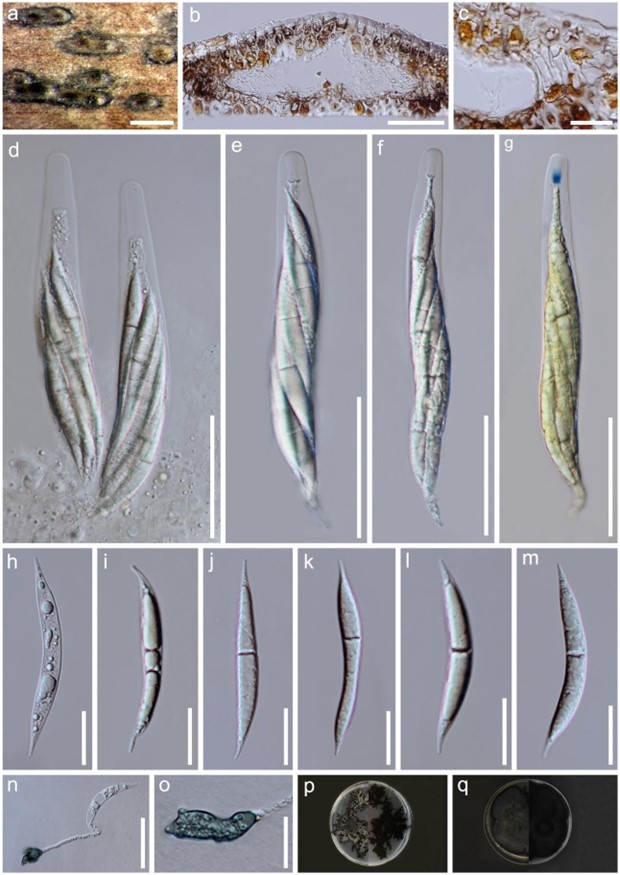Oxydothis phoenicis S.N. Zhang, K.D. Hyde & J.K. Liu, in Hyde et al., Mycosphere 11(1): 770 (2020)
MycoBank number: MB 555516; Index Fungorum number: IF 555516; Facesoffungi number: FoF 05092;
Saprobic on rachis of Phoenix paludosa. Sexual morph: Ascomata 230–600 μm diam., solitary or clustered in groups, forming under slightly raised, blackened, ellipsoidal regions on the host surface. Peridium 20–25 μm wide, composed of 2–3 layers of pale brown to hyaline cells with textura prismatica. Paraphyses seem to dissolve during maturation. Asci 142–159 μm × 14–21 μm ( x = 148.9 × 17 μm, n = 20), 8-spored, cylindrical, mostly straight, pedicellate, unitunicate, with a wedge-shaped, J+, subapical ring, 3.5–5 μm high, 3.5–4.5 μm diam. Ascospores 60–78 μm× 6–7.5 μm ( x = 72 × 6.7 μm, n = 30), fusiform, hyaline, obliquely 1–2-seriate, tapering gradually from a constricted central or seldom upper central septum to short, pointed processes. Asexual morph: Undetermined.
Material examined – Thailand, Chang Wat Chanthaburi, Amphoe Khlung, Tambon Wan Yao, on rachis of Phoenix paludosa (Arecaceae Roxb.), intertidal, 25 April 2017, S.N. Zhang, SNT134 (MFLU 18-1074 holotype); ibid., (HKAS 97485, isotype); ex-type living culture MFLUCC 18-0269 (= MFLUCC 18-0270).
GenBank numbers – Sequence data used in this study: ITS: MK088065 (MFLUCC 18-0269), LSU: MK088061 (MFLUCC 18-0269), SSU: MK088063 (MFLUCC 18-0269), ITS: MK088066 (MFLUCC 18-0270), LSU: MK088062 (MFLUCC 18-0270), SSU: MK088064 (MFLUCC 18-0270). Sequence data not used in this study but submitted in GenBank: tef1: MK087667 (MFLUCC 18-0269), tef1: MK087668 (MFLUCC 18-0270).
Notes – Oxydothis phoenicis is similar to O. asiatica, O. mauritiae, O. uniseriata and O. rattanica, but differs in ascospore and apical ring size (Fröhlich & Hyde 2000). Oxydothis phoenicis also shares similar ascospores and ascal apical rings with O. calami, O licualae (and O. rubella, but is distinct in ascomata morphology (Hyde 1993c). The phylogeny based on multi-gene analysis also supports O. phoenicis as an independent lineage and indicates it is distinct from other species with sequence data.

Figure 186 – Oxydothis phoenicis (MFLU 18-1074, holotype). a Appearance of fruiting bodies on host substrate. b Section of ascoma. c Peridium. d-g Asci. g Reaction of apical ring in Melzer’s reagent. h-m Ascospores. n Germinating ascospores. o Appressoria. p Colonies on PDA. q Colonies on MEA. Scale bars: a = 500 µm, b, d-g, n = 50 µm, c, h-m, o = 20 µm.
